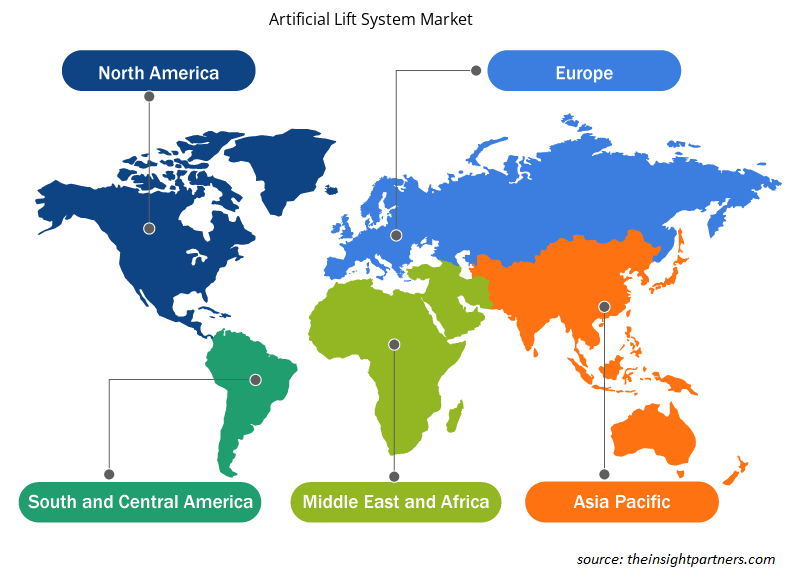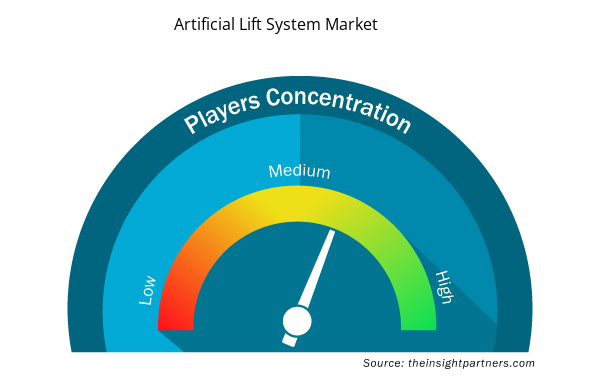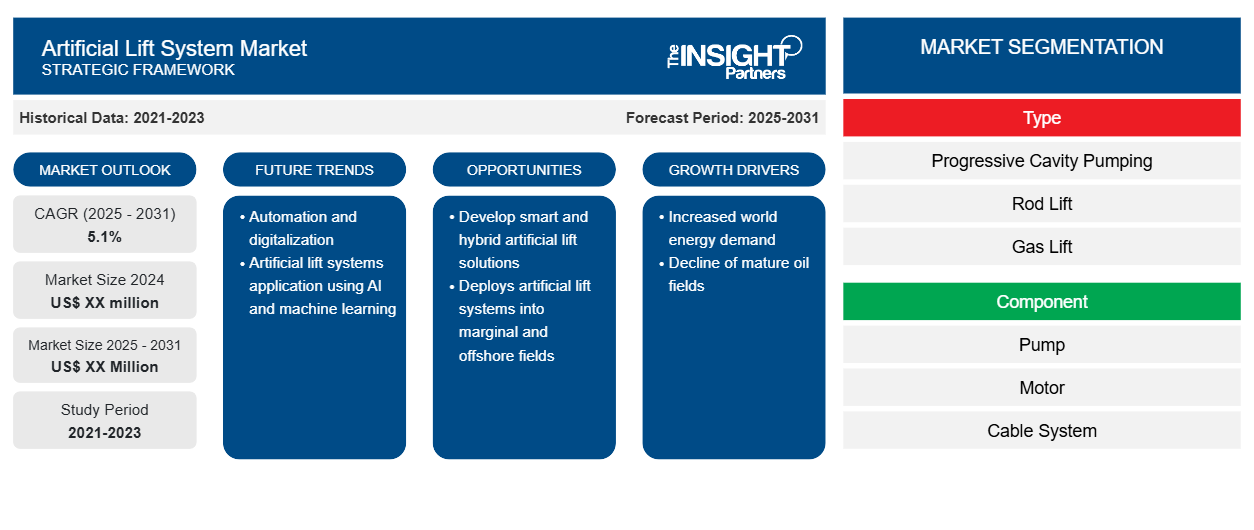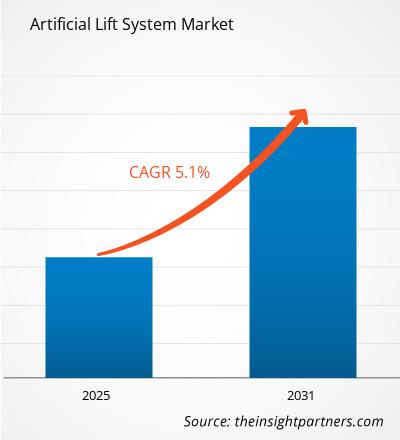MARKTÜBERSICHT
Künstliche Förderung ist eine Technik zur Steigerung der Bohrlochproduktion durch Verringerung des Bohrlochsohlendrucks (BHP) bei der Erschließung. Zur Reduzierung des Betriebsdrucks an der Pumpenansaugung kann eine Verdrängerpumpe wie beispielsweise eine moderne Exzenterschneckenpumpe (PCP) verwendet werden. Auch eine Bohrlochkreiselpumpe , die Teil eines elektrischen Tauchpumpensystems (ESP) sein kann, kann verwendet werden. Bei der Gasförderung sinkt die Dichte der Flüssigkeit in den Rohren, da die zum Anheben der Flüssigkeit verwendete Gasmenge erhöht wird. Dies führt zu einem niedrigeren Bohrlochdruck und einer höheren Durchflussrate. Diese Technik wird grundsätzlich verwendet, wenn der Bohrlochsohlendruck nicht ausreicht, um Öl an die Oberfläche zu treiben, und ist zu einem wichtigen Teil des Produktionsprozesses geworden, da sie zur Steigerung der Ölproduktion aus den Öllagerstätten eingesetzt wird.
Marktumfang und Berichtsfunktionen
Unser Bericht „Globale Marktanalyse für künstliche Hebesysteme bis 2031“ enthält eine detaillierte Marktanalyse wichtiger Segmente wie Typ, Komponente und Vertikale des Marktes für künstliche Hebesysteme sowie eine tiefgehende statistische und qualitative Analyse nach geografischen Gesichtspunkten, die fünf Schlüsselregionen und mehrere Länder abdeckt. Als Teil der qualitativen Analyse bietet der Bericht eine Bewertung der wichtigsten Marktdynamiken wie vorherrschende Markttreiber, wichtige Herausforderungen und Chancen, die den Weg für zukünftige Entwicklungen ebnen. Darüber hinaus bietet unsere Analyse der wichtigsten Konkurrenz einen strategischen Blickwinkel auf die Marktinitiativen, eine SWOT-Analyse und hebt die Produkt- und Serviceentwicklungen der Akteure hervor.
Passen Sie diesen Bericht Ihren Anforderungen an
Sie erhalten kostenlos individuelle Anpassungen an jedem Bericht, einschließlich Teilen dieses Berichts oder einer Analyse auf Länderebene, eines Excel-Datenpakets sowie tolle Angebote und Rabatte für Start-ups und Universitäten.
- Holen Sie sich die wichtigsten Markttrends aus diesem Bericht.Dieses KOSTENLOSE Beispiel umfasst eine Datenanalyse von Markttrends bis hin zu Schätzungen und Prognosen.
MARKTSEGMENTIERUNG
Globaler Markt für künstliche Hebesysteme – nach Typ
- Exzenterschneckenpumpe (PCP)
- Stangenlift
- Gasdruckfeder
- Elektrische Tauchpumpen (ESP)
- Sonstiges
Globaler Markt für künstliche Hebesysteme – nach Komponenten
- Medizinische Phototherapiepumpe
- Motor
- Kabelsystem
- Antriebskopf
- Pumpenheber
- Regler
- Separator
- Sonstiges
Globaler Markt für künstliche Hebesysteme – nach Branchen
- Onshore-Öl- und Gasindustrie
- Offshore-Öl- und Gasindustrie
REGIONALE EINBLICKE
Der Bericht bietet einen detaillierten Überblick über die Branche, der sowohl qualitative als auch quantitative Informationen enthält. Er bietet einen Überblick und eine Prognose des globalen Marktes basierend auf verschiedenen Segmenten. Er bietet auch Marktgrößen- und Prognoseschätzungen für die Jahre 2022 bis 2031 in Bezug auf fünf große Regionen, nämlich Nordamerika, Europa, Asien-Pazifik (APAC), Naher Osten und Afrika (MEA) und Südamerika. Der Markt für künstliche Hebesysteme wird nach Regionen später nach jeweiligen Ländern und Segmenten unterteilt. Der Bericht umfasst die Analyse und Prognose von 18 Ländern weltweit sowie die aktuellen Trends und Chancen in der Region. Der Bericht
analysiert Faktoren, die den Markt sowohl von der Nachfrage- als auch von der Angebotsseite beeinflussen, und bewertet darüber hinaus die Marktdynamik, die den Markt während des Prognosezeitraums beeinflusst, d. h. Treiber, Beschränkungen, Chancen und zukünftige Trends. Der Bericht bietet auch eine umfassende PEST-Analyse für alle fünf Regionen, nämlich Nordamerika, Europa, APAC, MEA und Südamerika, nachdem politische, wirtschaftliche, soziale und technologische Faktoren bewertet wurden, die den Markt für künstliche Hebesysteme in diesen Regionen beeinflussen.
Marktteilnehmer
Der Bericht behandelt wichtige Entwicklungen auf dem Markt für künstliche Hebesysteme als organische und anorganische Wachstumsstrategien. Verschiedene Unternehmen konzentrieren sich auf organische Wachstumsstrategien wie Produkteinführungen, Produktzulassungen und andere wie Patente und Veranstaltungen. Anorganische Wachstumsstrategien, die auf dem Markt beobachtet wurden, waren Übernahmen sowie Partnerschaften und Kooperationen. Diese Aktivitäten haben den Weg für die Ausweitung des Geschäfts und des Kundenstamms der Marktteilnehmer geebnet. Den Marktteilnehmern auf dem Markt für künstliche Hebesysteme werden in Zukunft lukrative Wachstumschancen erwartet, da die Nachfrage auf dem Weltmarkt steigt.
Der Bericht enthält auch die Profile wichtiger Unternehmen sowie deren SWOT-Analyse und Marktstrategien auf dem Markt für künstliche Hebesysteme. Darüber hinaus konzentriert sich der Bericht auf führende Branchenteilnehmer mit Informationen wie Unternehmensprofilen, angebotenen Komponenten und Dienstleistungen, Finanzinformationen der letzten drei Jahre und den wichtigsten Entwicklungen der letzten fünf Jahre.
- Baker Hughes Unternehmen
- Dover Artificial Lift, LLC
- Halliburton
- Tenaris
- Schlumberger Limited
- Weatherford
- NOV Inc.
- Boretten
- ChampionX
- JJ-TECHNIK
Regionale Einblicke in den Markt für künstliche Hebesysteme
Die regionalen Trends und Faktoren, die den Markt für künstliche Hebesysteme im Prognosezeitraum beeinflussen, wurden von den Analysten von Insight Partners ausführlich erläutert. In diesem Abschnitt werden auch Marktsegmente und Geografien für künstliche Hebesysteme in Nordamerika, Europa, im asiatisch-pazifischen Raum, im Nahen Osten und Afrika sowie in Süd- und Mittelamerika erörtert.

- Erhalten Sie regionalspezifische Daten zum Markt für künstliche Hebesysteme
Umfang des Marktberichts über künstliche Hebesysteme
| Berichtsattribut | Details |
|---|---|
| Marktgröße im Jahr 2023 | XX Millionen US-Dollar |
| Marktgröße bis 2031 | XX Millionen US-Dollar |
| Globale CAGR (2023 - 2031) | XX % |
| Historische Daten | 2021-2022 |
| Prognosezeitraum | 2024–2031 |
| Abgedeckte Segmente | Nach Typ
|
| Abgedeckte Regionen und Länder | Nordamerika
|
| Marktführer und wichtige Unternehmensprofile |
|
Marktteilnehmerdichte: Der Einfluss auf die Geschäftsdynamik
Der Markt für künstliche Hebesysteme wächst rasant, angetrieben durch die steigende Nachfrage der Endnutzer aufgrund von Faktoren wie sich entwickelnden Verbraucherpräferenzen, technologischen Fortschritten und einem größeren Bewusstsein für die Vorteile des Produkts. Mit steigender Nachfrage erweitern Unternehmen ihr Angebot, entwickeln Innovationen, um die Bedürfnisse der Verbraucher zu erfüllen, und nutzen neue Trends, was das Marktwachstum weiter ankurbelt.
Die Marktteilnehmerdichte bezieht sich auf die Verteilung der Firmen oder Unternehmen, die in einem bestimmten Markt oder einer bestimmten Branche tätig sind. Sie gibt an, wie viele Wettbewerber (Marktteilnehmer) in einem bestimmten Marktraum im Verhältnis zu seiner Größe oder seinem gesamten Marktwert präsent sind.
Die wichtigsten auf dem Markt für künstliche Hebesysteme tätigen Unternehmen sind:
- Baker Hughes Incorporated
- Dover Artificial Lift, LLC
- Flotek Industries, Inc.
- Halliburton
- Tenaris SA
Haftungsausschluss : Die oben aufgeführten Unternehmen sind nicht in einer bestimmten Reihenfolge aufgeführt.

- Überblick über die wichtigsten Akteure auf dem Markt für künstliche Hebesysteme
BERICHTSHIGHLIGHTS
Unser Bericht über den Markt für künstliche Hebesysteme deckt die folgenden Schlüsselparameter ab:
- Umfassende Marktanalyse auf globaler, regionaler und Länderebene
- Detaillierte PEST-Faktoren (politisch, wirtschaftlich, sozial und technologisch), die den Markt in wichtigen geografischen Regionen wie Nordamerika, Europa, Asien-Pazifik, Naher Osten und Afrika sowie Südamerika beeinflussen.
- Marktdynamik (Treiber, Hemmnisse, Chancen und zukünftige Trends) und Auswirkungsanalyse von Treibern und Hemmnissen auf kurze, mittelfristige und langfristige Sicht.
- Marktgröße und Prognosen in Bezug auf den Umsatz; 2021 (historisch), 2021 (Basisjahr), 2022–28 (Prognosezeitraum).
- Detaillierte Marktsegmentierung und tiefgehende Analyse auf regionaler und Länderebene von über 18 Ländern in fünf Schlüsselregionen.
- Wichtige Unternehmensprofile und Branchenlandschaften bieten Informationen zu den neuesten Marktinitiativen und der Wettbewerbslandschaft.
- Auswirkungen der COVID-19-Pandemie auf das Ökosystem und den Markt.
Das engagierte Forschungs- und Analyseteam von Insight Partner besteht aus erfahrenen Fachleuten mit fortgeschrittenem Statistik-Know-how und bietet verschiedene Anpassungsoptionen für die bestehende Studie.
- Historische Analyse (2 Jahre), Basisjahr, Prognose (7 Jahre) mit CAGR
- PEST- und SWOT-Analyse
- Marktgröße Wert/Volumen – Global, Regional, Land
- Branche und Wettbewerbsumfeld
- Excel-Datensatz



Report Coverage
Revenue forecast, Company Analysis, Industry landscape, Growth factors, and Trends

Segment Covered
This text is related
to segments covered.

Regional Scope
North America, Europe, Asia Pacific, Middle East & Africa, South & Central America

Country Scope
This text is related
to country scope.
Häufig gestellte Fragen
Some of the customization options available based on the request are an additional 3-5 company profiles and country-specific analysis of 3-5 countries of your choice. Customizations are to be requested/discussed before making final order confirmation# as our team would review the same and check the feasibility
The report can be delivered in PDF/PPT format; we can also share excel dataset based on the request
Increased world energy demand and decline of mature oil fields are the major factors driving the artificial lift system market.
Automation and digitalization and artificial lift systems application using AI and machine learning are likely to remain a key trend in the market.
The Artificial Lift System Market is estimated to witness a CAGR of 5.1% from 2023 to 2031
Trends and growth analysis reports related to Electronics and Semiconductor : READ MORE..
The List of Companies
1. Baker Hughes Incorporated
2. Dover Artificial Lift, LLC
3. Flotek Industries, Inc.
4. Halliburton
5. Tenaris S.A.
6. Cameron
7. GE-Alstom Grid
8. National Oilwell Varco
9. Weatherford International
10. Schlumberger
The Insight Partners performs research in 4 major stages: Data Collection & Secondary Research, Primary Research, Data Analysis and Data Triangulation & Final Review.
- Data Collection and Secondary Research:
As a market research and consulting firm operating from a decade, we have published and advised several client across the globe. First step for any study will start with an assessment of currently available data and insights from existing reports. Further, historical and current market information is collected from Investor Presentations, Annual Reports, SEC Filings, etc., and other information related to company’s performance and market positioning are gathered from Paid Databases (Factiva, Hoovers, and Reuters) and various other publications available in public domain.
Several associations trade associates, technical forums, institutes, societies and organization are accessed to gain technical as well as market related insights through their publications such as research papers, blogs and press releases related to the studies are referred to get cues about the market. Further, white papers, journals, magazines, and other news articles published in last 3 years are scrutinized and analyzed to understand the current market trends.
- Primary Research:
The primarily interview analysis comprise of data obtained from industry participants interview and answers to survey questions gathered by in-house primary team.
For primary research, interviews are conducted with industry experts/CEOs/Marketing Managers/VPs/Subject Matter Experts from both demand and supply side to get a 360-degree view of the market. The primary team conducts several interviews based on the complexity of the markets to understand the various market trends and dynamics which makes research more credible and precise.
A typical research interview fulfils the following functions:
- Provides first-hand information on the market size, market trends, growth trends, competitive landscape, and outlook
- Validates and strengthens in-house secondary research findings
- Develops the analysis team’s expertise and market understanding
Primary research involves email interactions and telephone interviews for each market, category, segment, and sub-segment across geographies. The participants who typically take part in such a process include, but are not limited to:
- Industry participants: VPs, business development managers, market intelligence managers and national sales managers
- Outside experts: Valuation experts, research analysts and key opinion leaders specializing in the electronics and semiconductor industry.
Below is the breakup of our primary respondents by company, designation, and region:

Once we receive the confirmation from primary research sources or primary respondents, we finalize the base year market estimation and forecast the data as per the macroeconomic and microeconomic factors assessed during data collection.
- Data Analysis:
Once data is validated through both secondary as well as primary respondents, we finalize the market estimations by hypothesis formulation and factor analysis at regional and country level.
- Macro-Economic Factor Analysis:
We analyse macroeconomic indicators such the gross domestic product (GDP), increase in the demand for goods and services across industries, technological advancement, regional economic growth, governmental policies, the influence of COVID-19, PEST analysis, and other aspects. This analysis aids in setting benchmarks for various nations/regions and approximating market splits. Additionally, the general trend of the aforementioned components aid in determining the market's development possibilities.
- Country Level Data:
Various factors that are especially aligned to the country are taken into account to determine the market size for a certain area and country, including the presence of vendors, such as headquarters and offices, the country's GDP, demand patterns, and industry growth. To comprehend the market dynamics for the nation, a number of growth variables, inhibitors, application areas, and current market trends are researched. The aforementioned elements aid in determining the country's overall market's growth potential.
- Company Profile:
The “Table of Contents” is formulated by listing and analyzing more than 25 - 30 companies operating in the market ecosystem across geographies. However, we profile only 10 companies as a standard practice in our syndicate reports. These 10 companies comprise leading, emerging, and regional players. Nonetheless, our analysis is not restricted to the 10 listed companies, we also analyze other companies present in the market to develop a holistic view and understand the prevailing trends. The “Company Profiles” section in the report covers key facts, business description, products & services, financial information, SWOT analysis, and key developments. The financial information presented is extracted from the annual reports and official documents of the publicly listed companies. Upon collecting the information for the sections of respective companies, we verify them via various primary sources and then compile the data in respective company profiles. The company level information helps us in deriving the base number as well as in forecasting the market size.
- Developing Base Number:
Aggregation of sales statistics (2020-2022) and macro-economic factor, and other secondary and primary research insights are utilized to arrive at base number and related market shares for 2022. The data gaps are identified in this step and relevant market data is analyzed, collected from paid primary interviews or databases. On finalizing the base year market size, forecasts are developed on the basis of macro-economic, industry and market growth factors and company level analysis.
- Data Triangulation and Final Review:
The market findings and base year market size calculations are validated from supply as well as demand side. Demand side validations are based on macro-economic factor analysis and benchmarks for respective regions and countries. In case of supply side validations, revenues of major companies are estimated (in case not available) based on industry benchmark, approximate number of employees, product portfolio, and primary interviews revenues are gathered. Further revenue from target product/service segment is assessed to avoid overshooting of market statistics. In case of heavy deviations between supply and demand side values, all thes steps are repeated to achieve synchronization.
We follow an iterative model, wherein we share our research findings with Subject Matter Experts (SME’s) and Key Opinion Leaders (KOLs) until consensus view of the market is not formulated – this model negates any drastic deviation in the opinions of experts. Only validated and universally acceptable research findings are quoted in our reports.
We have important check points that we use to validate our research findings – which we call – data triangulation, where we validate the information, we generate from secondary sources with primary interviews and then we re-validate with our internal data bases and Subject matter experts. This comprehensive model enables us to deliver high quality, reliable data in shortest possible time.


 Holen Sie sich ein kostenloses Muster für diesen Bericht
Holen Sie sich ein kostenloses Muster für diesen Bericht